Kakati Devi temple
What’s in the news?
- A temple constructed by Emperor Ganapati Deva, a mighty ruler of Kakatiya dynasty, in Dharanikota near present Andhra Pradesh capital Amaravathi has been converted into an abode of local goddess Balusulamma (Goddess Durga).
About the temple
- The presiding deity at this 13th century temple was Kakati Devi, the tutelary deity of Kakatiya rulers. Due to ravages of time and for no upkeep, the presiding deity got damaged.
- The temple was constructed by emperor Ganapati Deva.
- The ceiling bears decorations of lotus medallions and no sikhara on its top. These architectural features are totally akin to their counterparts found in shrines at Hanamkonda and Warangal fort etc., – the original homeland of the Kakatiya dynasty.
- Ganapati Deva is the first king who introduced the worship of Kakati Devi into the coastal region of Andhra and outside the dominions of his kingdom

Specialities of the idol
- The goddess is gracefully seated in Padmasana with eight hands. Her facial physiognomic features are oval, distinguished with slender cheeks, wide open eyes, an elongated nose and closed tender pair of lips.
- She has eight hands and poses eight different special attributes. Her lower right hand is benevolently blessing the devotees.

Additional Details
Kakatiya Dynasty
- The Kakatiya dynasty was a South Indian dynasty whose capital was Orugallu, now known as Warangal. It was eventually conquered by the Delhi Sultanate.
- They were known for the construction of multiple tanks for irrigation and drinking water.
- Most of the Kakatiya records do not mention the varna (social class) of the family, but the majority of the ones that do, proudly describe them as Shudra. Examples are the Bothpur and Vaddamanu inscriptions of Ganapati’s general Malyala Gunda senani.
- The Kakatiyas also maintained marital relations with other Shudra families, such as the Kotas and the Natavadi chiefs. All these evidences indicate that the Kakatiyas were of Shudra origin.
- A few copper-plate inscriptions of the Kakatiya family describe them as belonging to the Kshatriya (warrior) varna. The term “Kshatriya” in these panegyric records appears to signify the family’s warrior-like qualities rather than their actual varna
- Some of the important constructions under the Kakatiyas are:
- Thousand Pillar Temple (Rudreshwara Swamy Temple) It is a star-shaped, triple shrine (Trikutalayam) dedicated to Vishnu, Shiva and Surya.
- Golconda Fort in Hyderabad– Later, it became the capital of the Qutb Shahi kings. (The Qutb Shahi dynasty ruled the Golconda Sultanate in south India from 1518 AD to 1687 AD)
- Ramappa Temple also known as the Ramalingeswara temple- The temple is a shiva temple, where Lord Ramalingeswara is worshipped. Marco Polo, during his visit to the Kakatiya Empire, allegedly called the temple “the brightest star in the galaxy of temples”
Kakatiya Dynasty and Koh-i-Noor
- Koh-i-Noor was acquired by Alauddin Khalji, second ruler of the Khalji dynasty of the Delhi Sultanate, when he invaded the kingdoms of southern India at the beginning of the 14th century and was probably in the possession of the Kakatiya dynasty (possibly from the Golconda mines). It later passed to succeeding dynasties of the Sultanate, and Babur received the diamond in 1526 as a tribute for his conquest of Delhi and Agra at the Battle of Panipat.
King Ganapati Deva
- King Ganapati Deva significantly expanded Kakatiya lands during the 1230s when he launched a series of attacks outside the dynasty’s traditional Telangana region and thus brought under Kakatiya control the Telugu-speaking lowland delta areas around the Godavari and Krishna rivers.
- Ganapati Deva was keen to bolster the dynasty’s economy. He encouraged merchants to trade abroad, abolishing all taxes except for a fixed duty and supporting those who risked their lives to travel afar. He created the man-made Pakhal Lake.
Reference:
Subscribe
Login
0 Comments
